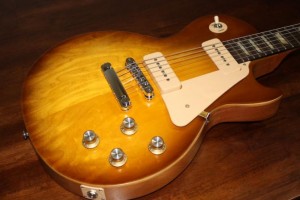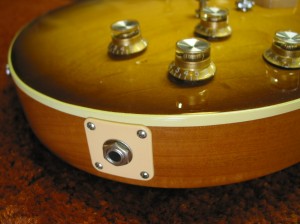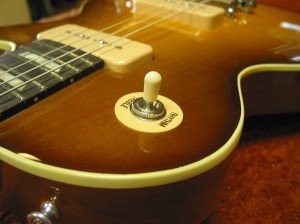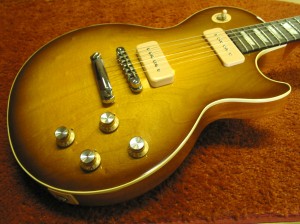*Okay, not really. Some guitars look like they could use binding, but just wouldn’t be worth the expense of adding it. Here’s a different approach that we think turned out great.

A customer brought in a new Les Paul 60’s Tribute Studio (not this one – we forgot to take before pictures once again.) It’s a nice looking guitar with a very tastefully done ‘honeyburst’ and matte top finish. As with other Studios, there’s no binding but they left the side of the maple cap clear so it sort of implies a line of binding – like you’d see on a Paul Reed Smith. It doesn’t look bad, but the owner felt like something was missing and wanted it to look more like a Standard Les Paul. He asked about adding a gloss finish and binding.
The gloss was no problem, but to add real binding the way it should look would require taking the neck off, routing a binding channel, binding the guitar, and possibly refinishing the top and or sides – and that’s before we think about binding the neck too. Too much. …Well what about painted-on binding?
We couldn’t think of a good reason not to, so we gave it a shot and were pleased with the results. See the pics below!

We stripped the guitar of all its hardware and electronics, taped off both the top and side, and airbrushed a cream-colored “binding” strip that is visible on both surfaces.
You’ll notice we didn’t “bind” the neck. We considered it, didn’t think it would look right to paint only the side of the fretboard. Binding has depth and you’d see it looking straight on as well as from the side. To get the rosewood face painted would require taping off or scraping the frets themselves and afterward spraying clear paint to protect the cream color from the constant friction of a left hand… it just seemed like more work than we or the owner felt was necessary. We think it looks great just like this.

Turns out there’s a very good reason why Gibson binds their guitars while they’re still in pieces and unfinished. It’s easier and it looks better that it would to try to bind a finished guitar. The gloss shows up a little less in this final pic, but you can see what a difference the painted binding line makes on this guitar. It turned out to be a really good call and at a fraction of what we’d have to charge for actual plastic binding.


Looks very nice, excellent detailed job. I guess that’s how a lot of cheap japanese knockoffs were ‘bound’ back in the day. I have a Maya LP knockoff done that way and looks fairly good to me.
Very nice! It would be nice if you provided larger pictures so we could better appreciate the results.
For some reason our web template used to make those pics zoom-able and doesn’t anymore. I’m not sure why but if there’s one you’d like to see full size, let me know and I’ll email it to you.
Hi there,
I just stumbled upon this site. How much, for a job like this? I actually picked up a les paul standard plus, which is obviously bound, and picked up the tribute. I would like the gloss finish, and the “binding” look.
Thanks.
David, this job runs around $450 including a gloss finish on the whole guitar and the “binding.” It makes such a difference on those guitars.
Nice looking work on this guitar. I have a Les Paul Studio 60’s tribute gold top, what would the approximate charge for just binding the guitar?
Regards
Alan
Alan, thanks for checking in. I’ll email you an estimate shortly. -Steve
nice job man :) but how did you tape the top? I mean, it seems nearly impossible to follow the body’s shape with a piece of tape XD how did you do it? :)
Alex, for a job with curves like this, we use a flexible pin-striping tape that is usually available as an auto-finishing supply. It’s got more of a rubbery surface than the normal paper-backed masking tapes.
Steve,
Like Alan, I am interested in what it would cost for just the binding?
Matt,
The whole job of painting the binding lines and glossing the body is $450. If you want to gloss the neck/headstock as well, you’d be at $500. If you’re talking about doing the binding without gloss, we’d still have to shoot some top sealer coats and just skip the buffing stage. It might save $50 or so to do it that way.
You really got a nice effect with the spray, Steve. Which kind of airbrush did you used? Do you think it would be possible to spray a binding like the custom shop one (with several layers of binding)?
Anyway, congrats, I guess a lot of people will start spraying their studios now :)
We generally use a Paasche airbrush and Husky spray guns. Part of the beauty of this little trick is its simplicity. So while I suppose one could go to the trouble of layering the binding look, it would be a lot of work to do so. Probably enough work to merit simply buying one with real binding – an option which would have the added bonus of not driving Dan crazy.
Hey guys i really enjoy this work, im currently in Sweden so i cant find any luthiers here to do this, so my question is, how did you masked the top of the guitar so the tape doesnt get crappy placed? i tried that once but curving tape is very hard. Greetings from Halmstad.
Andreas, I’ll find a link to the tape we use and email it to you. -Steve
Did you have to spray over the top or just buff it out? If you sprayed, did you use nitro or acrylic lacquer? Thank you…
Peter, we do spray a clear top coat any time we’re applying color – including over the “binding” paint here. We treat it the same as if we’d shot color over the whole body. It’s got to have a top coat or it will rub off. This client wanted it glossy so we went all out with wet-sanding and buffing. As far as material, we used nitro here as we would with any Gibson, Martin, or other lacquer-finished guitar.
Hey there. I’m doing a diy on my old gibson studio les paul. It would be awesome to do this. Can you give more detail on taping things off? how much room did you leave on the top and the sides? Also, what color cream did you use? Looks amazing by the way.
Tanner, we mix our own paints here to get the color right. As for the dimensions of the “binding,” we measured the binding on a couple of LP Standards and used those measurements. Ultimately we trust our own eyes to tell us when something looks right or not. …Do this work long enough and you start noticing the difference that 1/64th of an inch makes!
We don’t use StewMac finishes here; we use enough quantity that we order directly from a supplier. But generally speaking, a skilled guitar finisher using good quality nitrocellulose lacquer should be able to get a good gloss finish even when shooting over a satin nitro finish. I don’t recommend experimenting on a Les Paul if you’re just learning though. Use a beater or something that doesn’t matter too much to you.
Good luck!
Hi,
Nice job on the paint on binding. I have a plus top 2013 Studio Deluxe II and I am an experianced custom painter. I am planning on doing this and have a couple of questions. I am experianced using an airbrush and understand all the preparing and taping. I have mixed the color I want and am using one shot. I have succesfully shot nitro over the one shot but it is tedious as you need to go very slow to avoid too much solvent penetration. Because there is risk in doing this to get a gloss finish and buildup to blend the paint edge, I was hoping you would let me know what type of paint you are using for the color binding? I would assume lacquer but that’s why I am asking. Lacquer paint in small quantities are hard to locate now days.
Thanks,
Dale
Dale,
Sorry for the slow response. We did use lacquer, yes, with standard color tints. Both should be available at http://www.stewmac.com
Did you sand the binding line! I assume you used nitrocellulose lacquer?
We did use nitro yes and no we didn’t do any sanding on that binding line.
Would it be possible to bind a neck?
From what I know it would involve removing the fretboard, de-fretting the board and milling the binding width of the edges + reassembly. (this how Gibson refrets bound guitars, minus the milling bit)
I ask because there are several models that just look naked without said neck binding and I’d be willing to pay to have said job done if it were possible.
Sorry for this very late reply. An Epiphone Les Paul Standard is a real Les Paul made by Epiphone that feaeruts neary all the Gibson feaeruts. The Epiphone les paul 100 is a cheap les-paul style copy guitar that feaeruts barely any of the actualy Les Paul feaeruts at all.
Robert, In the sense that nearly everything is possible in our line of work, yes, it’s possible. And the process could take place in a way similar to what you describe. But overall, there’s a good reason why binding of necks gets done before assembly of the guitar. If you think about the area over the body, to mill/rout that binding channel without harming the top or finish would be a very tall order. So maybe you remove the neck beforehand. But if you factor in the cost of a neck removal and reset on top of the routing, binding and finish touch-up, you’re probably past the cost of a model that already has binding. What we like about this approach is that it’s less invasive and stays in keeping with the budget-oriented design of this guitar.
That looks great. I have a 2000 Gary Moore model Les Paul. Would doing this to my Gary Moore devalue it? It’s it perfect shape and has been going up in value.
Mio,
I wouldn’t expect faux binding to add to a guitar’s value, though it depends on who’s thinking about buying it. If it’s someone who prefers the bound look then it may be more valuable to that person. Overall though, it’s not likely to be a significant amount the way it would be on a truly vintage instrument and that guitar would be a good candidate for this work.
Hey I recently came across the issue with most epiphione Les Paul’s .I bout a 2015 plus top pro and also thought something was missing so I decided to sand with a slit bevel block in the painted over binding and achieved the same look with some final buffing over 2000 grit sanding and have ached fantastic results ..and idbint coast more than 20 bucks….lol